The Baltimore Orioles are a rebuilding baseball team. Everybody knew that coming into the season, and it hasn’t changed now that we’re in July. A successful 2019 season for the Orioles would involve prospects continuing to develop on the farm, improvement made in the structure of the front office, and getting a clearer picture of which major league players are going to be a part of the team going forward. In other words, not a lot of winning is part of the plan. Yet, I found myself so excited to watch the Orioles game against the Angels on July 26th.
A bright part of any rebuild is seeing which players emerge and become legitimate pieces of a team. Whether it’s the team’s top prospect that a team spent a top pick on and is hedging a lot of the future on or the fringey prospect that ends up making a big impact or the veteran that emerges in a new environment amid low expectations, these situations usually play out on many rebuilding teams.
As this is the first “official” rebuilding year for the Orioles, this is the period where it’s still too early for their top prospects to debut, but we are at the point in the rebuild where some potential key pieces of the future start to emerge. Trey Mancini has established himself as a top-quality MLB hitter, with other bats such as Anthony Santander and Renato Nuñez emerging as legitimate hitters this season and potentially opening the door for themselves to stick around and be a part of the team going forward.
Yet, with all of the attention focused on youth in Baltimore, I think the most intriguing player on the team is Asher Wojciechowski. At 30 years old, Wojciechowski may not be on or a major part of the next great Orioles team, but he could be a quality major league starting pitcher, and that definitely has value—in both real life and in fantasy baseball. He has been one of the most talked-about starting pitchers in baseball this month, with the high point of the month being when he flirted with a no-hitter against a strong Red Sox lineup where he struck out ten in seven and a third innings. Then he followed it up with a solid six strikeout, two runs allowed performance against the Angels, which got our attention even more.
It’s usually dangerous to put a lot of stock into a few good performances, especially when the pitcher in question is a guy who most have probably never heard of before like Wojciechowski. And there is a good reason to be suspicious—just take a look at his big-league career numbers before July 2019:
| Time Frame | IP | ERA | FIP | xFIP | K% | BB% | wOBA |
| Pre-2019 | 78.2 | 6.64 | 4.95 | 4.91 | 22.4 | 7.3 | .381 |
| 2019 | 30.0 | 3.60 | 3.92 | 4.31 | 31.1 | 6.7 | .281 |
There’s no other way to describe Wojciechowski’s pre-2019 performance other than bad. Results like that are how a player bounces around from organization to organization and spending all of 2018 and most of 2019 in the minor leagues. He wasn’t even getting great results in AAA this year either, with a 3.61 ERA and 3.72 FIP with the Columbus Clippers, the Cleveland Indians’ AAA-affiliate. With an opt-out incoming on his minor league contract, Cleveland shipped him to Baltimore, a team desperately needing innings, for cash. I doubt that the Baltimore front office would have expected results like this, but I guess only they know (I wouldn’t put it past them since the new Orioles regime has had a lot of past success with “fixing” players during their time in Houston). Since coming to Baltimore, Wojciechowski has been truly sensational. Take a look at this:
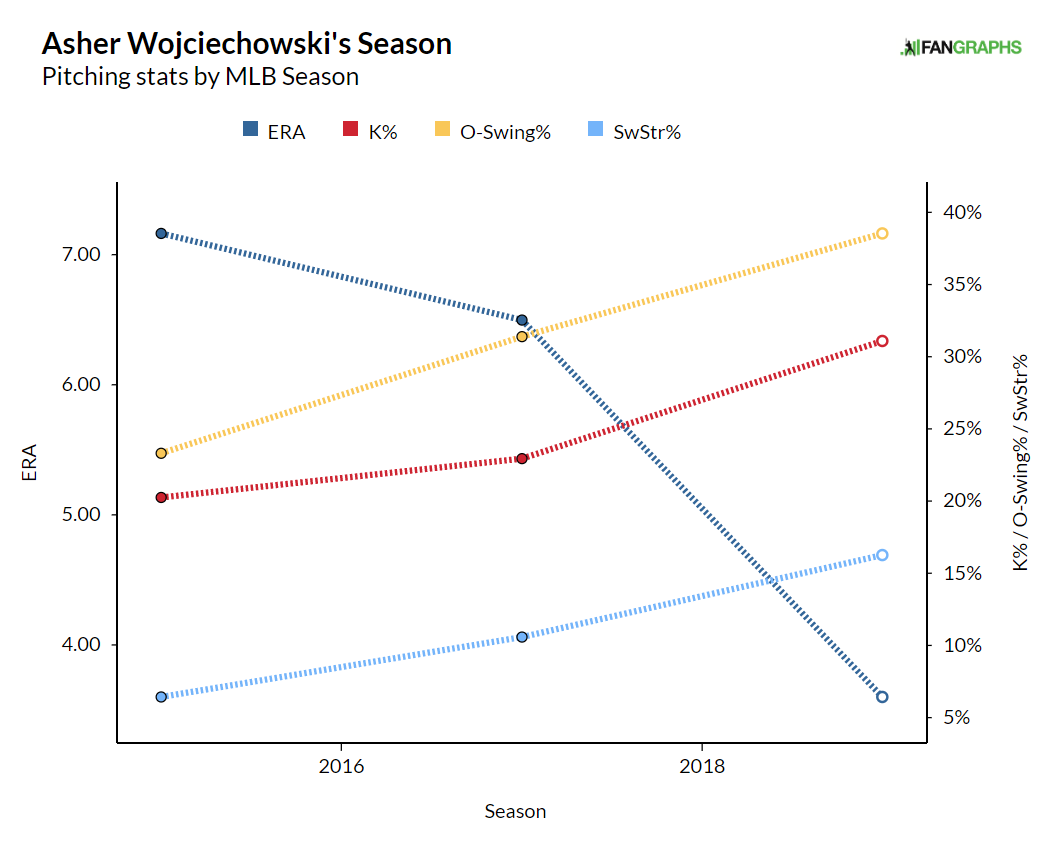
To this point in 2019, Wojciechowski has seen surges in his strikeout rate, O-swing rate and his swinging-strike rate which has helped his ERA drop to the best mark of his career. In fact, what he has done in a small sample of innings thus far puts him in an exclusive company:
| Name | Team | K% | BB% | K-BB% | ERA | FIP | xFIP | SIERA | SwStr% | O-Swing% |
| Max Scherzer | Nationals | 35.3 | 4.7 | 30.7 | 2.41 | 2.10 | 2.83 | 2.88 | 17.1 | 35.7 |
| Jacob deGrom | Mets | 31.2 | 6.1 | 25.1 | 2.86 | 2.95 | 3.29 | 3.41 | 15.2 | 38.0 |
| Justin Verlander | Astros | 32.8 | 5.6 | 27.2 | 2.86 | 3.94 | 3.57 | 3.27 | 15.6 | 37.6 |
| Gerrit Cole | Astros | 37.3 | 6.5 | 30.8 | 2.94 | 3.08 | 2.69 | 2.89 | 15.8 | 35.1 |
| Asher Wojciechowski | Orioles | 30.2 | 6.9 | 23.3 | 3.68 | 4.08 | 4.48 | 3.80 | 16.4 | 39.0 |
| Blake Snell | Rays | 32.9 | 8.5 | 24.5 | 4.28 | 3.41 | 3.24 | 3.51 | 17.8 | 37.2 |
This leaderboard shows all the starting pitchers with a strikeout rate of at least 30%, a walk rate of less than 10%, a swinging-strike rate of at least 15% and an O-Swing rate of at least 35%, with a minimum of twenty innings pitched. I will admit that a sample of 20 innings is laughable, but this is the best way to compare Wojciechowski to other pitchers. But within this, Wojciechowski compares well to some of the best pitchers in baseball, which I would say is a good sign.
We see that Wojciechowski is the best pitcher in this group at getting hitters to chase and also one of the best at getting swinging-strikes. He is also the overall league-leader for O-Swing rate. That’s right. I wasn’t expecting that when I hit “sort” on my spreadsheet and you weren’t either, but here we are. And while that doesn’t yet show up in his ERA, FIP or xFIP, a 3.80 SIERA is definitely solid and will play in today’s pitching environment. If we want to get even more ridiculous with it, if we look only from July 16th to today, he has a 2.29 ERA, 23rd among starting pitchers, and a 31.5% strikeout rate, which is in the top 20. If he keeps up with this profile, it would be a pretty good bet that his ERA indicators will look much better also.
Right to Break It
We now know that Asher Wojciechowski has done a lot of things well that put him in a group of some of the best pitchers in baseball, the next step is to look more in-depth at how he is getting these results.
Looking at his pitch mix, there is disagreement among the major pitch tracking outlets about what pitches he is actually throwing. Baseball-Savant thinks it’s mostly four-seamer and curveball with a hint of a slider. Brooks-Baseball thinks it’s a four-seamer, slider and cutter and Pitch Info pretty much thinks the same. Asher discussed it himself with The Baltimore Sun here and the answer, in short, is it’s complicated.
While in the Indians organization, Wojciechowski used data produced by Edgertronic cameras to help him refine his pitches. He says that the pitch that gets classified as a slider is more of a slurve and that the cutter he throws is intended to look more like a slider. With the Indians, the team looked at the Edgertronic data and suggested he add a pitch to complement the slurve, which is where the cutter came from. He never threw a cutter in the majors before this season, but the pitch has been a big part of his success thus far.
The next layer of his pitch mix is that he manipulates the slurve depending on the game situation. He says he likes to use the slurve as curveball early in the count and then turn to the slider-type movement for whiffs. He also adds that he changes the way the cutter moves in the same way and that he increases the movement of the pitch when he needs a whiff. Whatever the technical specifications of the pitch are, it is good to see that the success can be traced back to adjustments and that it looks less like he is just lucking his way into a short run of strong performances.
And oh yeah, the pitch is pretty nasty too. Whatever we want to call it-curve, slider, cutter—I’m just going to call it a breaking ball for simplicity, the pitch is getting results. Here it is against Jackie Bradley, Jr.:
And here’s a pitch with good movement that fools Mookie Betts:
And just so it doesn’t look like I’m only picking on the Red Sox, here he is confusing Andrelton Simmons:
The pitches do what he wants them to do, which is get whiffs and they both end up in roughly the same area, but they are different. The three pitches in the GIFs above range from 81 to 86 MPH and result in swings and misses. It’s a good sign to be able to change speeds and get whiffs with multiple variations of the pitch. This has helped Wojciechowski deliver a .168 wOBA on the pitch that Baseball-Savant classifies as a curveball, which is one of the best in baseball, with a ridiculous 48.7% strikeout rate. The pitch has been the main driving force behind his good run of results, but it is not the only pitch in his repertoire that is helping him out.
Blast From the Fast
The two most recent seasons Wojciechowski has been in the majors before 2019 were 2015 and 2017. In those years, his four-seamer had a wOBA allowed of .433 and .407, respectively. I don’t care how good your breaking ball may be, it’s hard to survive for long in the majors without a legit fastball. Fortunately, that is another area Wojciechowski has improved this year. His four-seamer has a wOBA allowed of .274, which is not great, but it is surely not bad. That .274 mark is better than pitchers such as Walker Buehler, Gerrit Cole and Shane Bieber, among others, and should not be overlooked when evaluating his strong results to the season.
The pitch is getting more whiffs than it ever has for him. Compare the fastball locations pre-2019 to 2019:
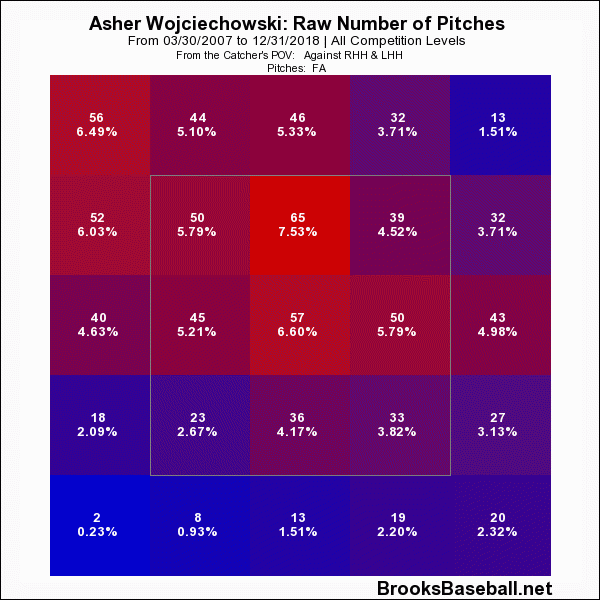
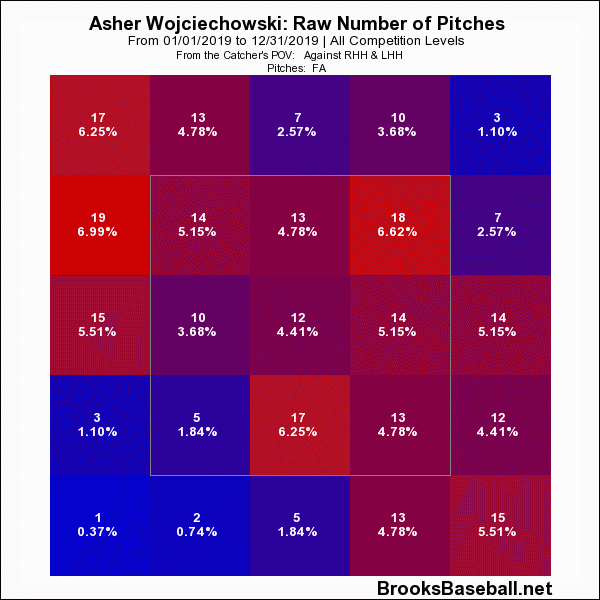
The main takeaway I get from these two charts is that in 2019, Wojciechowski is moving the fastball around more. Pre-2019, he was locating the fastball too much in the heart of the plate and wasn’t trying to paint the corners as much as he is currently. He’s doing a good job thus far of keeping hitters honest by changing up his fastball location. He seems to be trying to get hitters to chase more, which makes sense when we remember that he has one of the highest O-Swing rates among starting pitchers in 2019. By doing this, it’s no surprise that we get results like this that look so much better to what he previously did in his career:

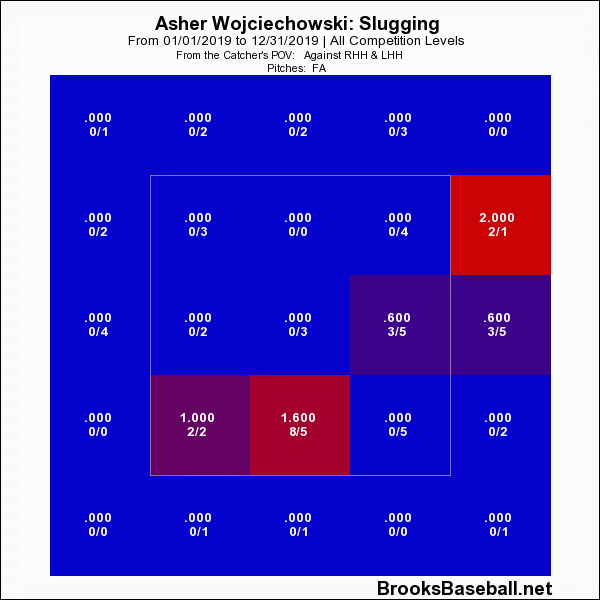
It shouldn’t come as a surprise that when he left a fastball in the heart of the plate he would get shelled. It’s highly unlikely that he maintains slugging percentages allowed of zero in all of these zones going forward, but it is good to see that now that he is doing a better job mixing up his fastball location and it’s no longer getting hit hard as it had in the past.
Going in hand with fastball location, it seems that in his two most recent starts against the Red Sox and Angels, Wojciechowski has embraced what we like to call here at Pitcher List the “Blake Snell Blueprint,” which, in case you are unfamiliar with the term, basically means putting fastballs up and breaking balls down. Here are his pitch plots from the starts against the Red Sox and the Angels:
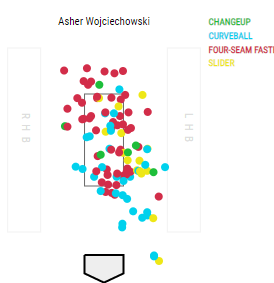
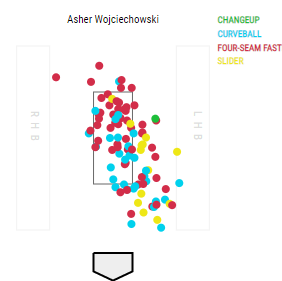
That looks like a lot of fastballs up in the zone and a lot of breaking balls down. This is almost exactly what we would want to see if we were trying to show off what the Blake Snell Blueprint is, so that’s good. Now compare how those plots looked compared to what it looked like from his July 16th start against the Nationals where he gave up three runs and six hits in less than six innings:
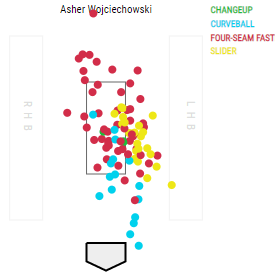
The majority of his fastballs are in the middle or low portion of the plate, with the pitch being classified as a slider being a little too high most of the time as well. It shouldn’t come as a surprise that the starts against Boston and Los Angeles saw Wojciechowski produce his best CSW rates of the season, with 32% in both of them. Elevating his fastball more helps to set up the lethal breaking pitches he possesses, which help him get better results.
While it may still be too premature to call Asher Wojciechowski a success story, there is a lot to like about what he’s done in a small sample for the Orioles this year. Using technology and data, Wojciechowski has redefined his pitch mix, offering a new platter of breaking balls that confuses both analysts and hitters alike. With this new ability to change speeds comes with a new ability to generate whiffs, with rates that put him in good company with some of the best pitchers in baseball. He also has redefined how he has used his fastball and it is currently getting the best results it has in his career. Add all that up and you get a pitcher that should be a more-than-serviceable piece in a big-league rotation, and hopefully a bright spot on an Orioles team that is trying to get through some lean years.
Featured Image courtesy of Carrie Giordano/Icon Sportswire.


Great stuff! It looks like he may be on an innings limit. How many more starts do you see him having?
I haven’t seen anything saying there is an innings limit on him, but I don’t follow the Orioles that closely so I could have missed it, but I picked him up everywhere and will be letting him go whenever he pitches unless they say he’s not pitching anymore.
Also, do you think he can weather the horrid schedule he seems to be facing?
It is going to be tough for sure, but he does do a lot of things that put him in position for success. If you can get away with keeping him as a streaming option and just picking him up for good matchups that would probably be better, but those tough matchups will be a good litmus test and if he passes then it’s even more reason to be excited.
Indians are going to be hating life if Woj pans out. They did all the hard work of turning his career around and then gave him away for nothing!